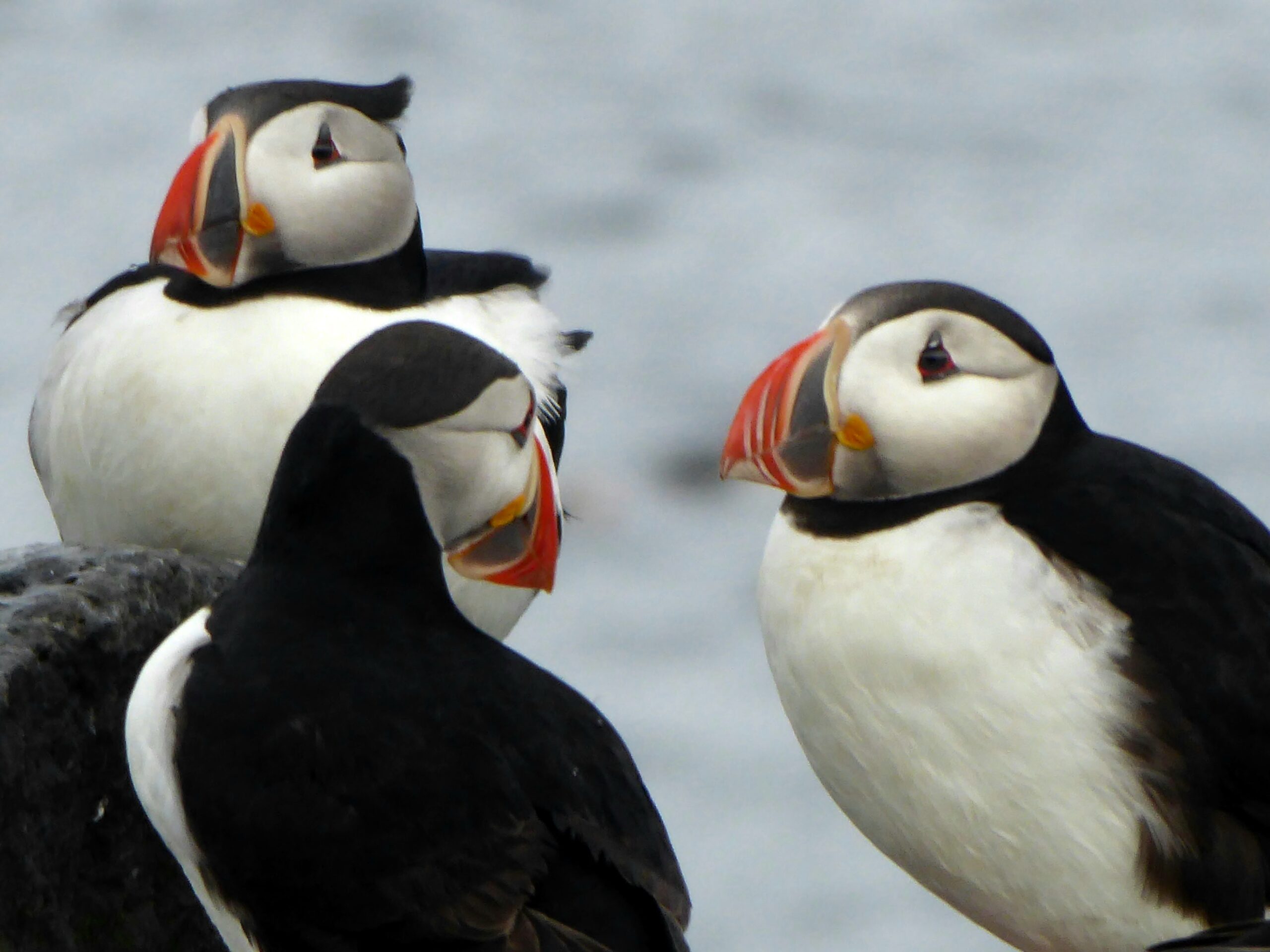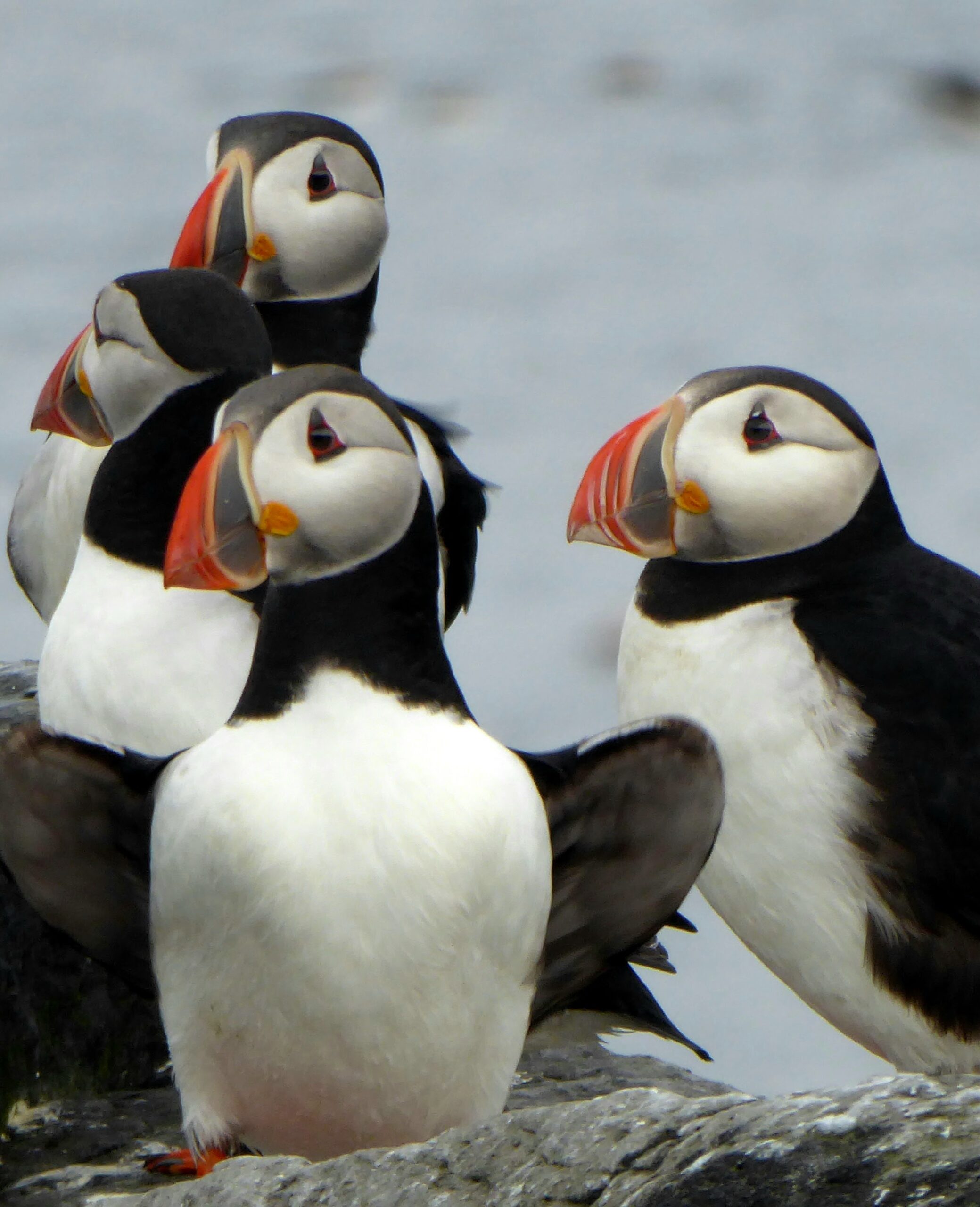Iceland is not noted for its efficient public transportation, which makes it ideal for road trips. I was limited by little more than my whims, not wishing to spend too many hours each day in the car, and the weather.
Although Iceland may not have the expanse of many countries, the open vistas, far-reaching sea, fresh air, unobstructed sky, and quiet roads felt boundless.
It was almost easy to forget the ongoing pandemic, and the difficulties others were facing — until speaking with loved ones.
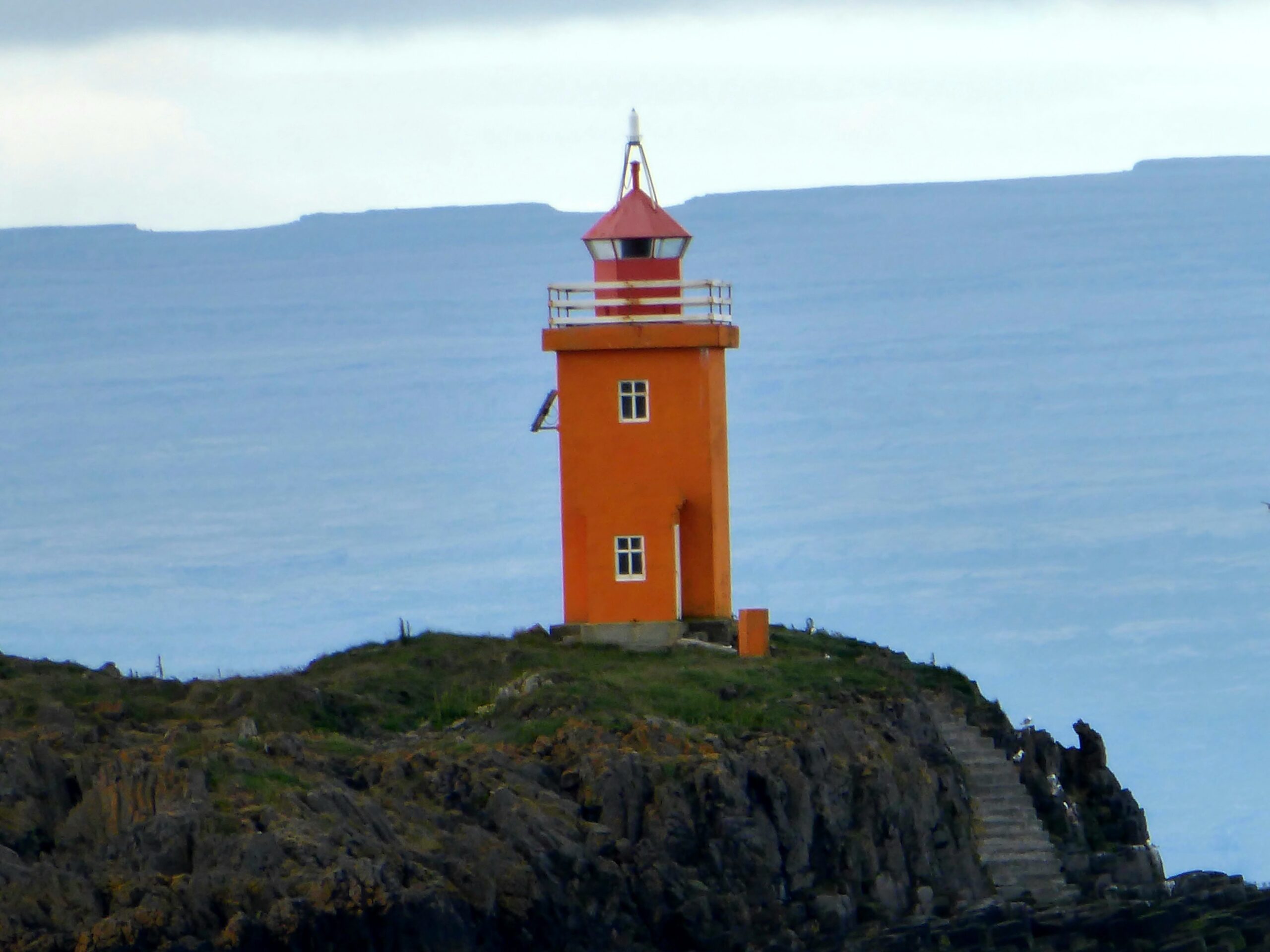
After Stykkisholmur I arrived in Budardalur, a small town you can drive by in less than a minute, and decided to stay the night. The Castle Guesthouse, despite its name, is an ordinary-looking wooden building, but the owner, who lived on site with her family, was extremely warm and welcoming. After an easy exchange, she suggested a few things to do. The first, was to follow the trail across the street and walk along the fjord. I spent hours admiring the changing sky, sea, and view.
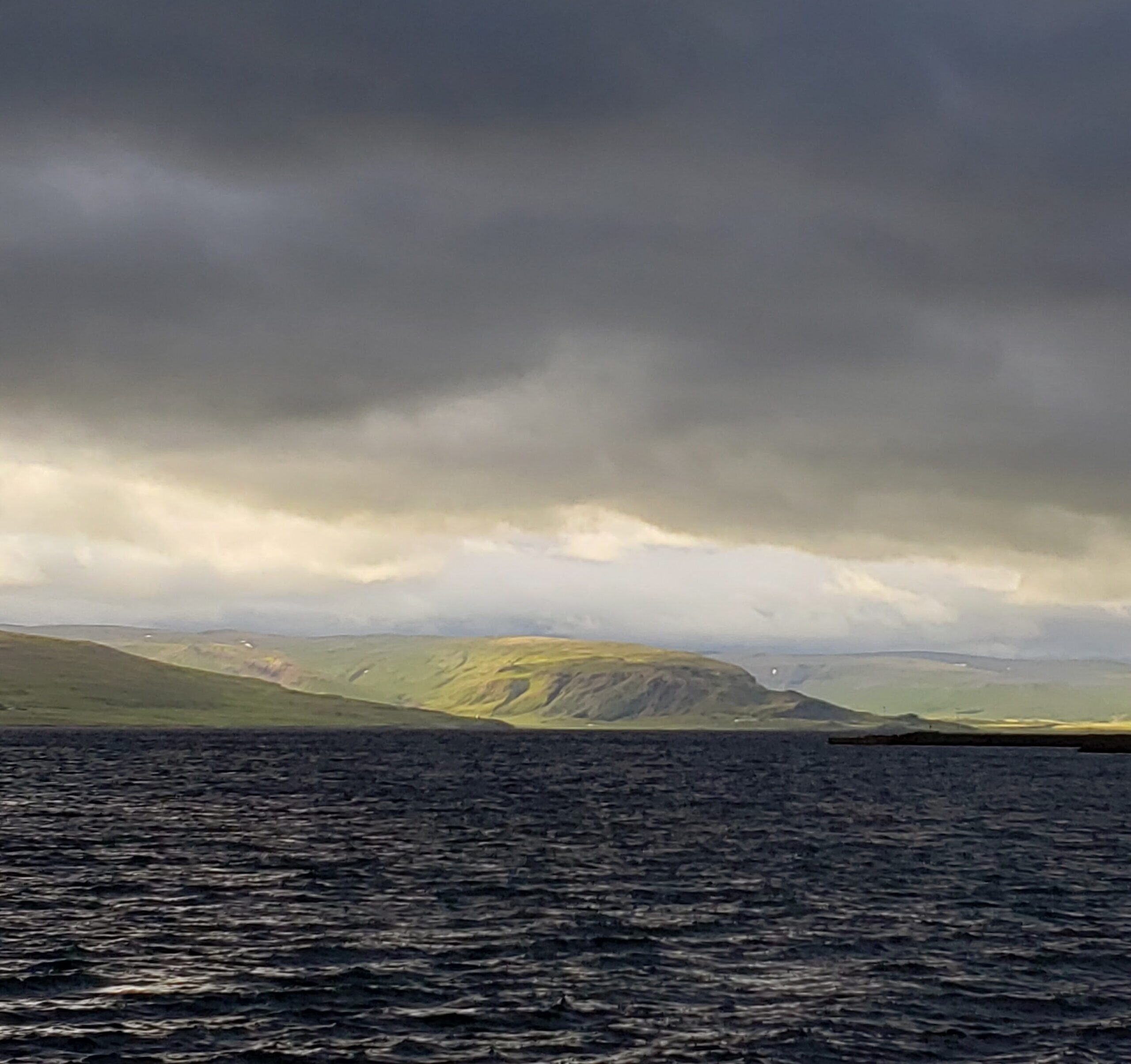
The Leif Eiriksson Center was a new addition in town, and complemented the open-air museum a short drive away. It offered exhibitions of Eiriksson’s travels to Greenland, Canada, and the US, 500 years before Columbus while introducing a slew of colorful characters. I wasn’t expecting much and even hesitated going in, but the audio guide and wonderfully carved wooden figures succeeded in transporting me to another time.
Budardalur’s main road had a shop where a woman minding it was busily adding to the stock of hand-knitted woolen sweaters. I was tempted to buy one, but knowing I have to pack and carry what I own is an effective deterrent to acquiring more than I need.
Next door was a bright restaurant with mostly empty tables. The waitress greeted me in English. I joked that I should have bought an Icelandic sweater to blend in better, but she was from Romania, and didn’t speak Icelandic either. Many foreigners come for work and not speaking Icelandic isn’t unusual she explained.
After a leisurely breakfast (I rarely rush in the morning having done enough of that in my working years) I left Budardalur on Rte. 60, a smooth, paved surface. And shortly after, following the coast, I turned onto the unpaved Rte. 590, the beginning of the Klofningsvegur Peninsula.
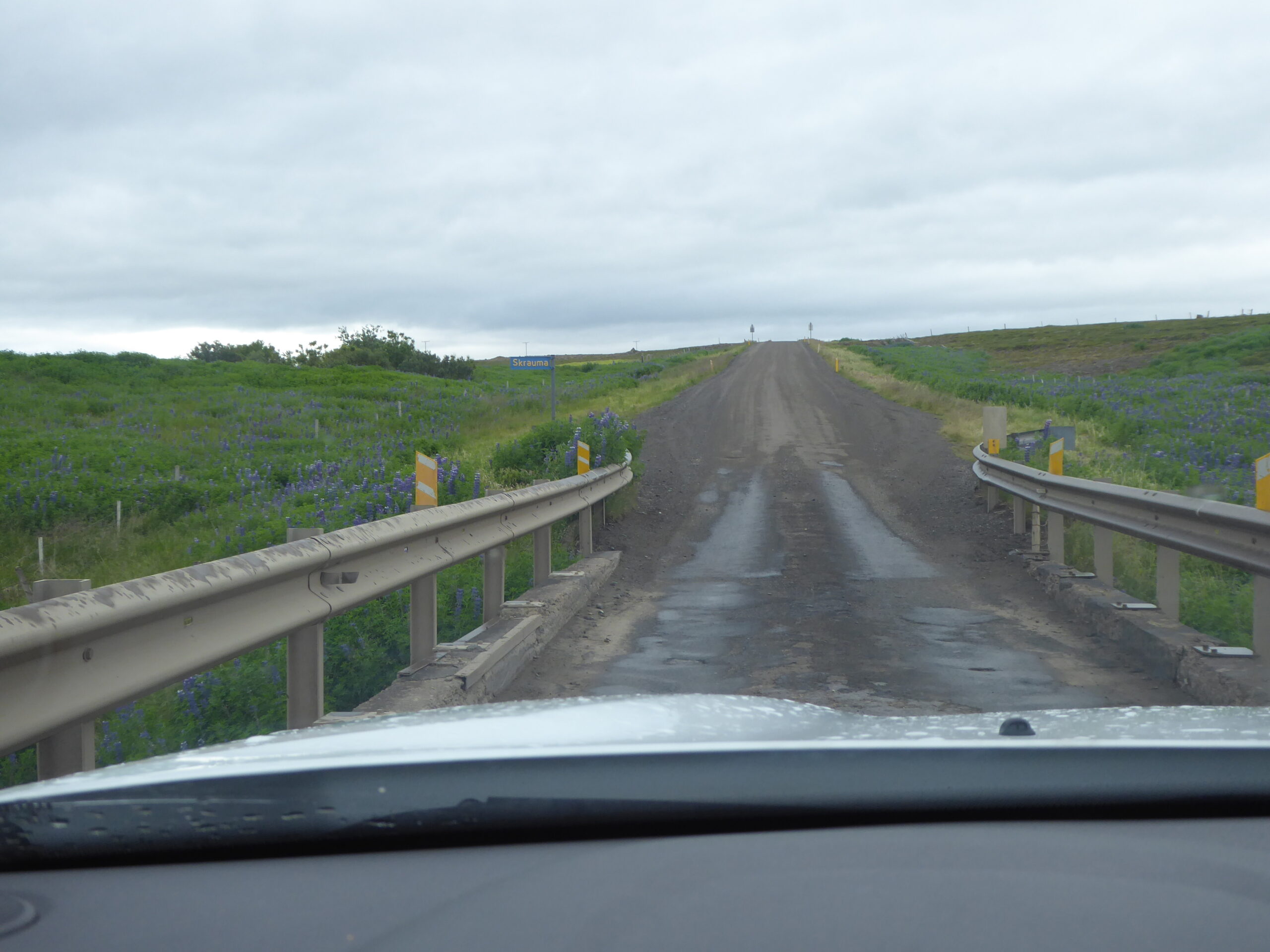
It was a quiet, desolate stretch, except for the wind and the sounds my car made rumbling over the road decorated with potholes. I wasn’t surprised few drivers opted to go this way.
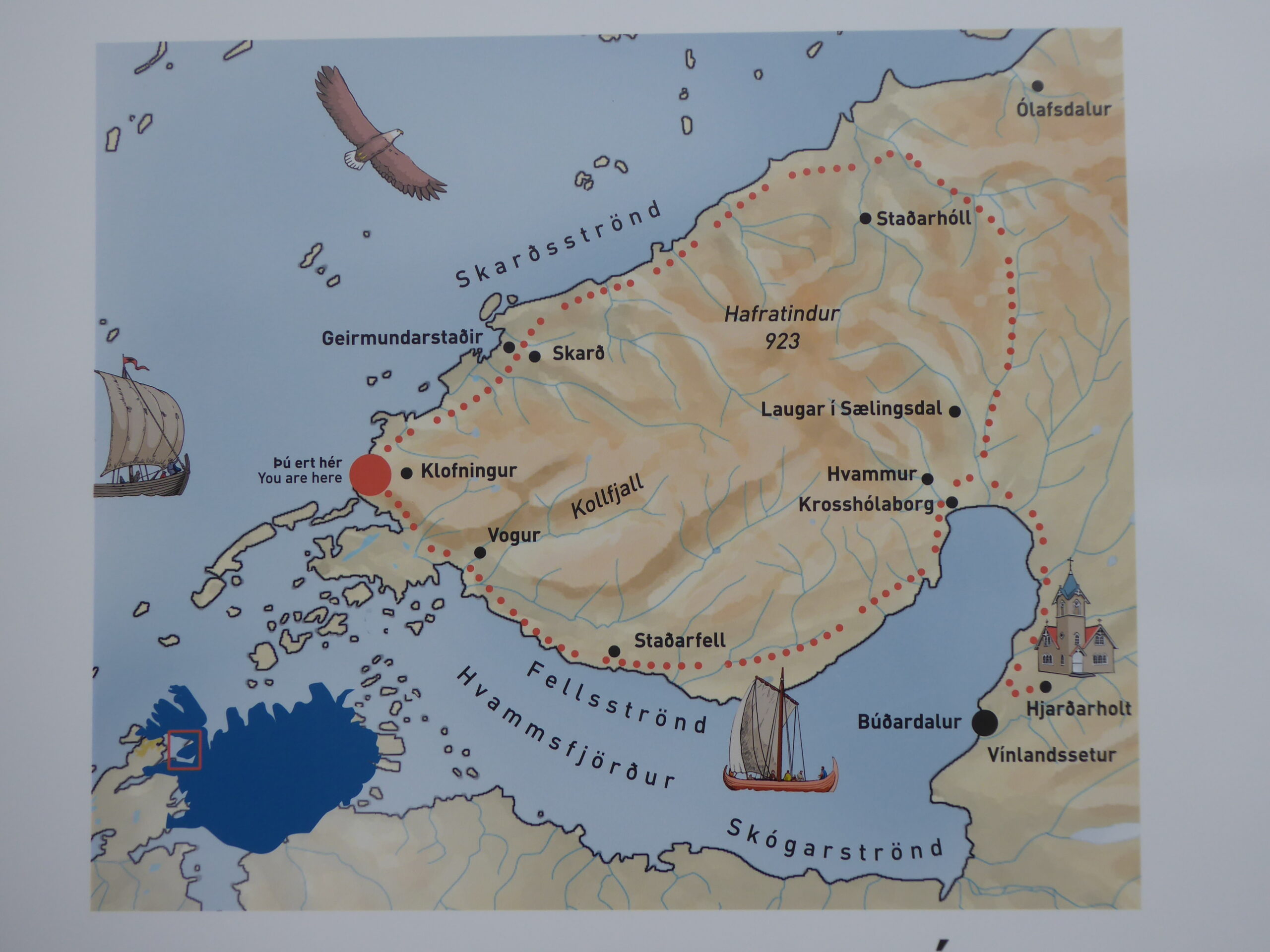
Except for a lone church and a few scattered farms there was little sign of human habitation before reaching the Nyp Guesthouse. The owners had been restoring the once abandoned farmhouse over the past twenty years. Clearly a labor of love, the guesthouse was beautifully enhanced with the owners’ art and marvelous views. Guests were offered breakfast—and if desired, dinner too. (I didn’t even consider driving elsewhere that evening.) The food all came from local sources, including the owners’ garden.
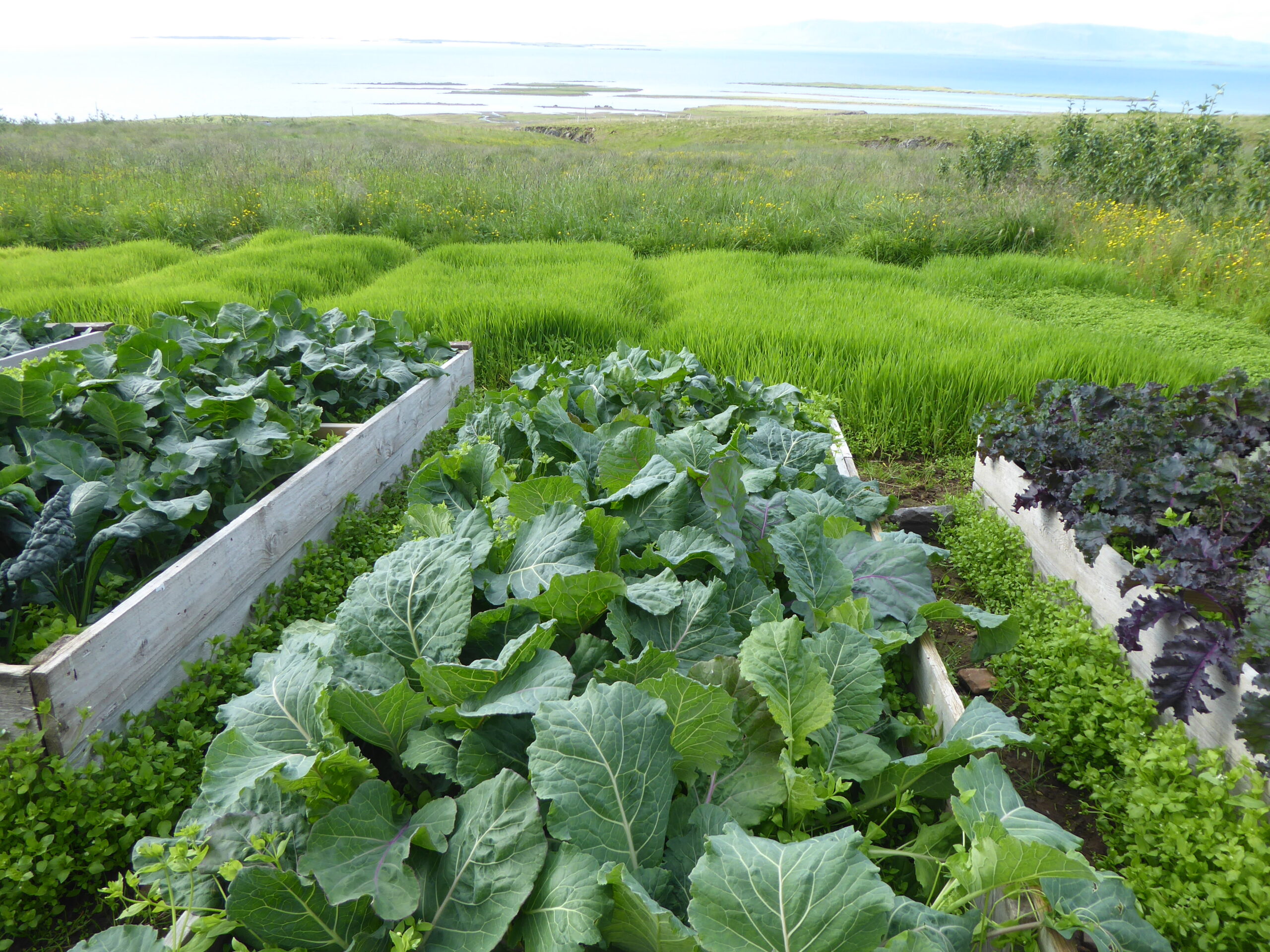
The fish was fresh and delicate, roasted vegetables were sweet, and the salad, with only the slightest touch of dressing filled my mouth with more flavors than seemed possible. There was no resemblance to the pre-packaged salads, I admittedly eat too often, that have texture, but barely any taste at all.
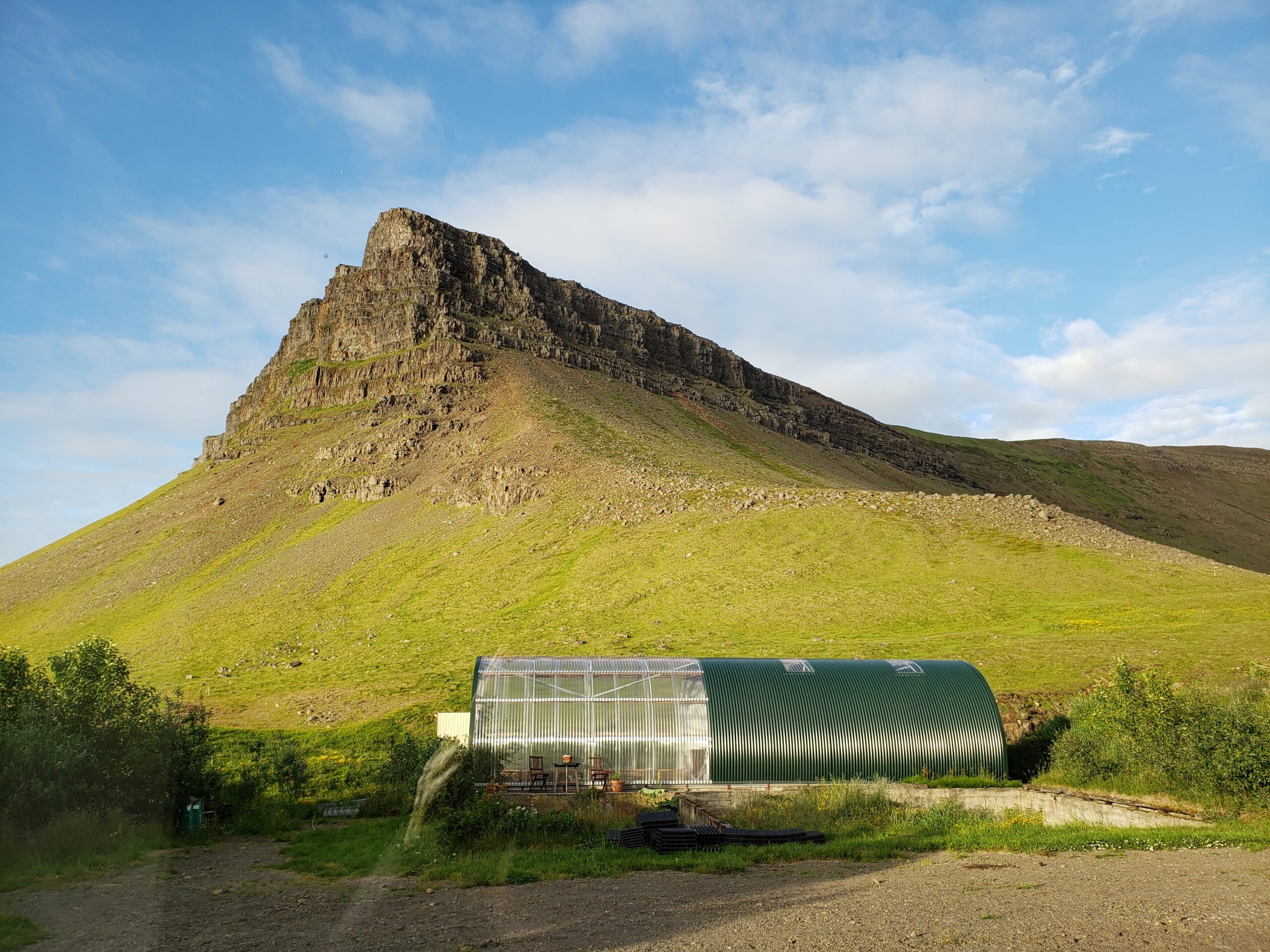
In my room a book, Dada- Collage and Memoirs, caught my eye and learned the owners’ had known the author, Frank Ponzi.
Wanting to finish it would later lead me to the author’s son, Tomas Ponzi, and his family including his adult son, his present wife and infant son, his ninety-plus-year-old mother who’d sung opera, and a tour of his greenhouses where he and his wife were cultivating an amazing assortment of tomatoes—he offered me some delicious samples (I’d have welcomed more)—and an unexpected connection with author Halldor Laxness who’d lived next door. I left with a copy of the book.
Since books are a necessity, I exclude them from my acquisition rule (although when I’m finished with one, I pass it on ). Having bought Jules Verne’s Journey to the Center of the Earth at the Snaefellsjokull Visitor Center was a particular treat. It’s the very glacier where the journey in the book begins.
Books are my constant traveling companions. Although a Kindle would weigh less and my selection would not be limited to what I can find while traveling, the pleasure I get from “unplugging” and turning a page makes the transition non-negotiable. And my search for books is like an ongoing treasure hunt—I never know what gems I will find.
My passion for books didn’t develop until I was in college. Television in my younger years had far more appeal. Movies reigned supreme, but I’d be amiss to deny my delight watching shows of the 60’s like Batman, The Avengers, I Dream of Jeannie, The Prisoner, Get Smart, and Bewitched. I digress.
Next stop was Holmavik, a small coastal village whose economy seemed reliant on the shrimp processing plant and tourism. The Museum of Icelandic Sorcery and Witchcraft, filled two floors of an old harbor building. The very sensitive might have found the exhibits disturbing. A replica of Necropants, a pair of pants made from the lower half of a dead human being—this one was definitively male, featured prominently in the collection. According to folklore it was believed the wearer would receive an endless supply of money. Whether such pants ever existed is for the viewer to decide. And those prone to nightmares might have benefitted from a stop into the cheery cafe just next door before departing.
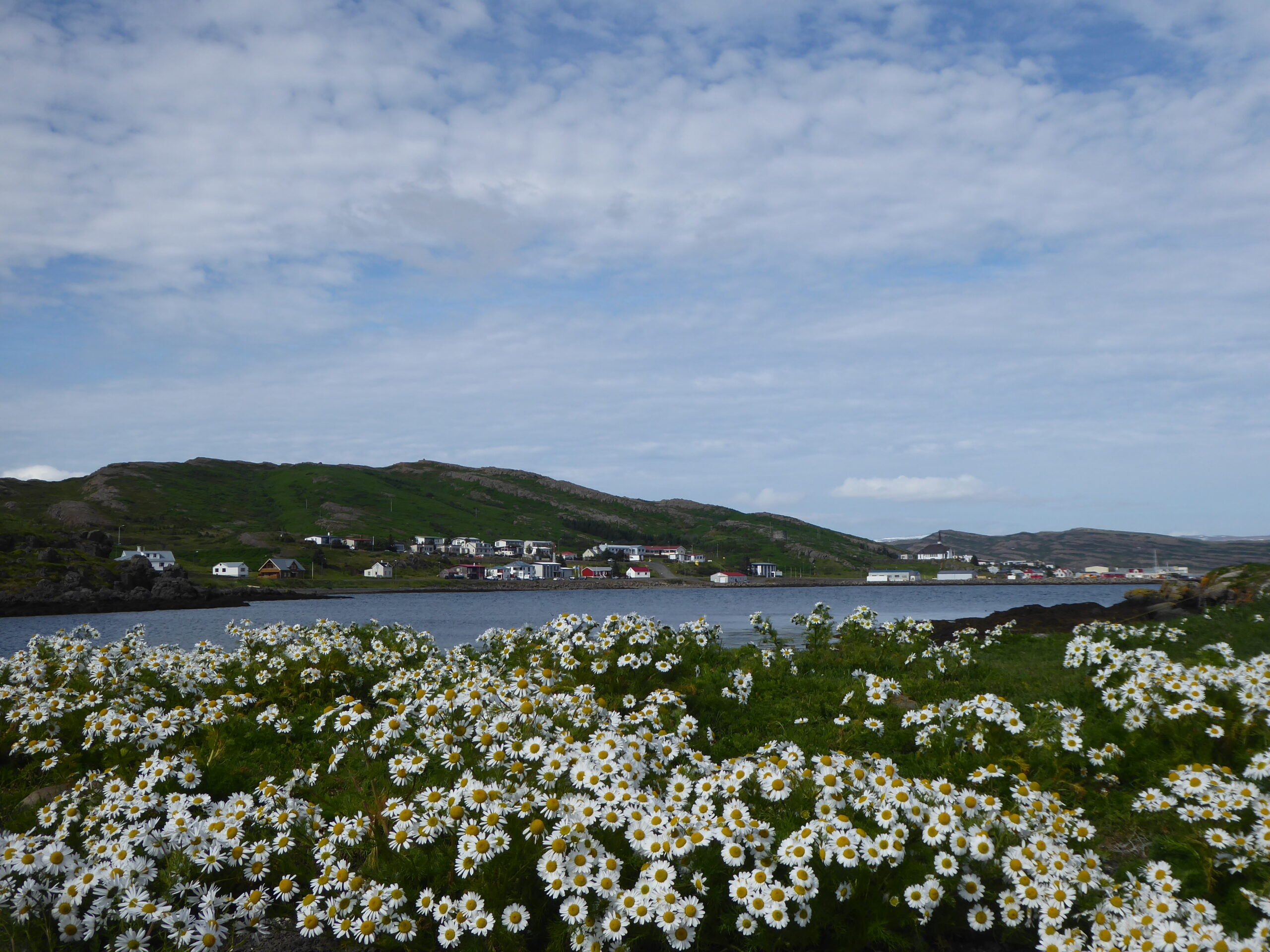
The town was a great base to explore the area.
Djupavik can be reached by Rte. 643, a narrow gravel road. I was glad traffic was light: there were few guard rails, precarious drops, and sharp, blind turns. But the views were stunning.
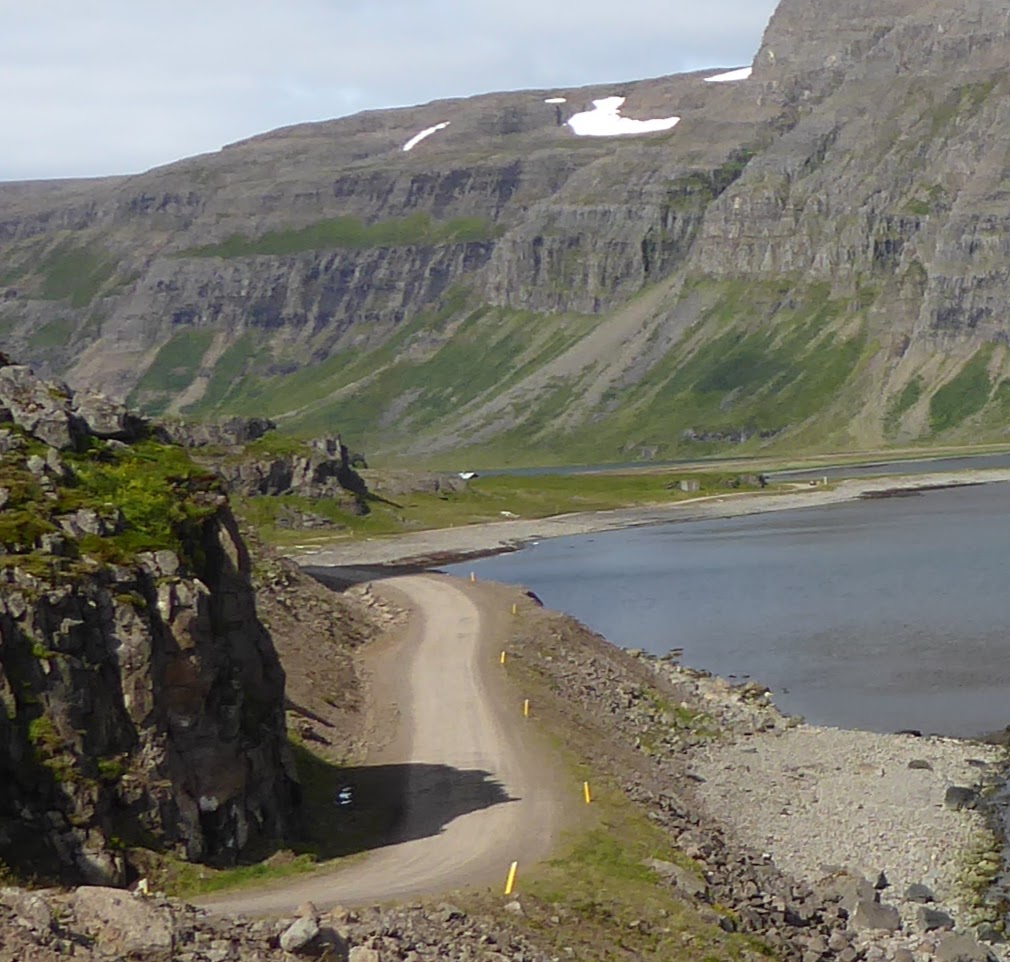
When I arrived at the Djupavik Hotel, lunch of homemade soup and fresh bread was being served. I helped myself to the buffet in the crowded dining room—there were no masks, no social-distancing — and sat at the one free table. Conversations in Icelandic filled the room.
Djupavik was once the site of the first fully automated fish factory in Europe, built in 1934 when herring were abundant, but overfishing depleted their numbers and operations ceased twenty years later.
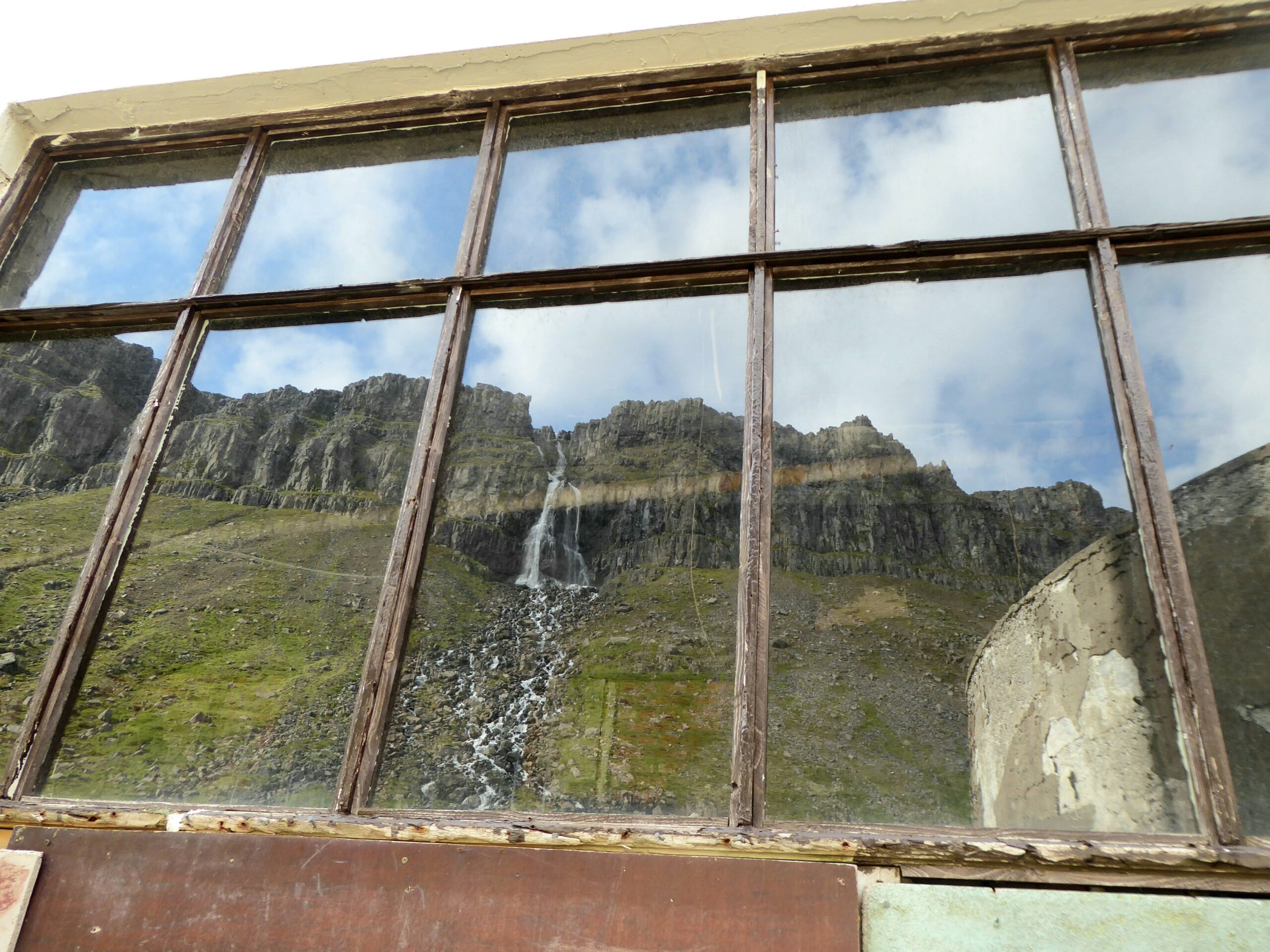
I signed up for an afternoon tour of the factory. When I arrived the man giving it was speaking only Icelandic to a gathered group of tourists. When the group wandered off, I asked the guide a few questions. The quick exchange revealed that he was the owners’ son, had lived in Brooklyn a few years, was almost done guiding the group, and if I could wait a short while, kindly offered to give me a private tour.
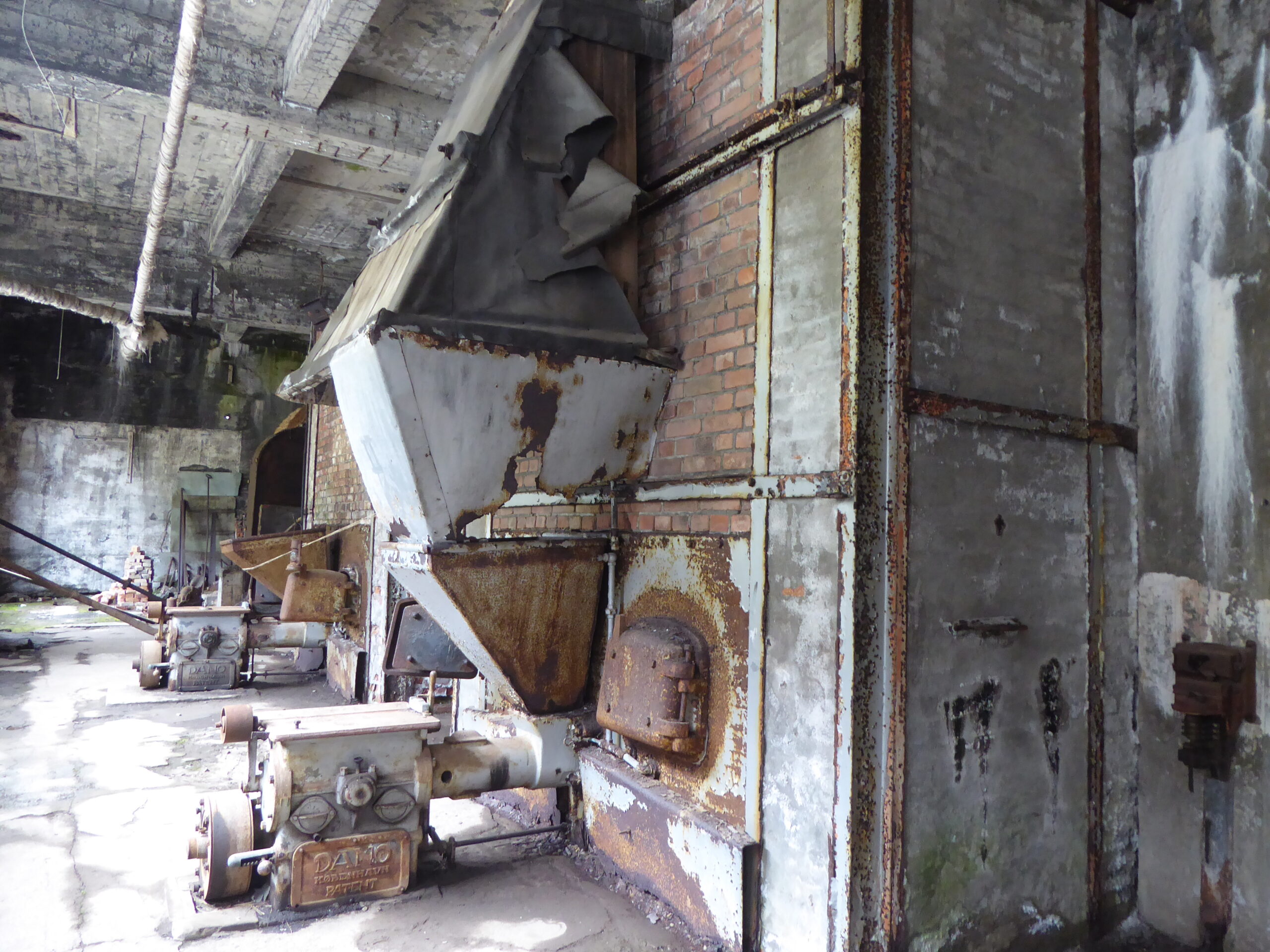
I wandered around the immense facility — it showed little sign of renovation, including The Factory, a space dedicated to showcasing contemporary art–before being joined again.
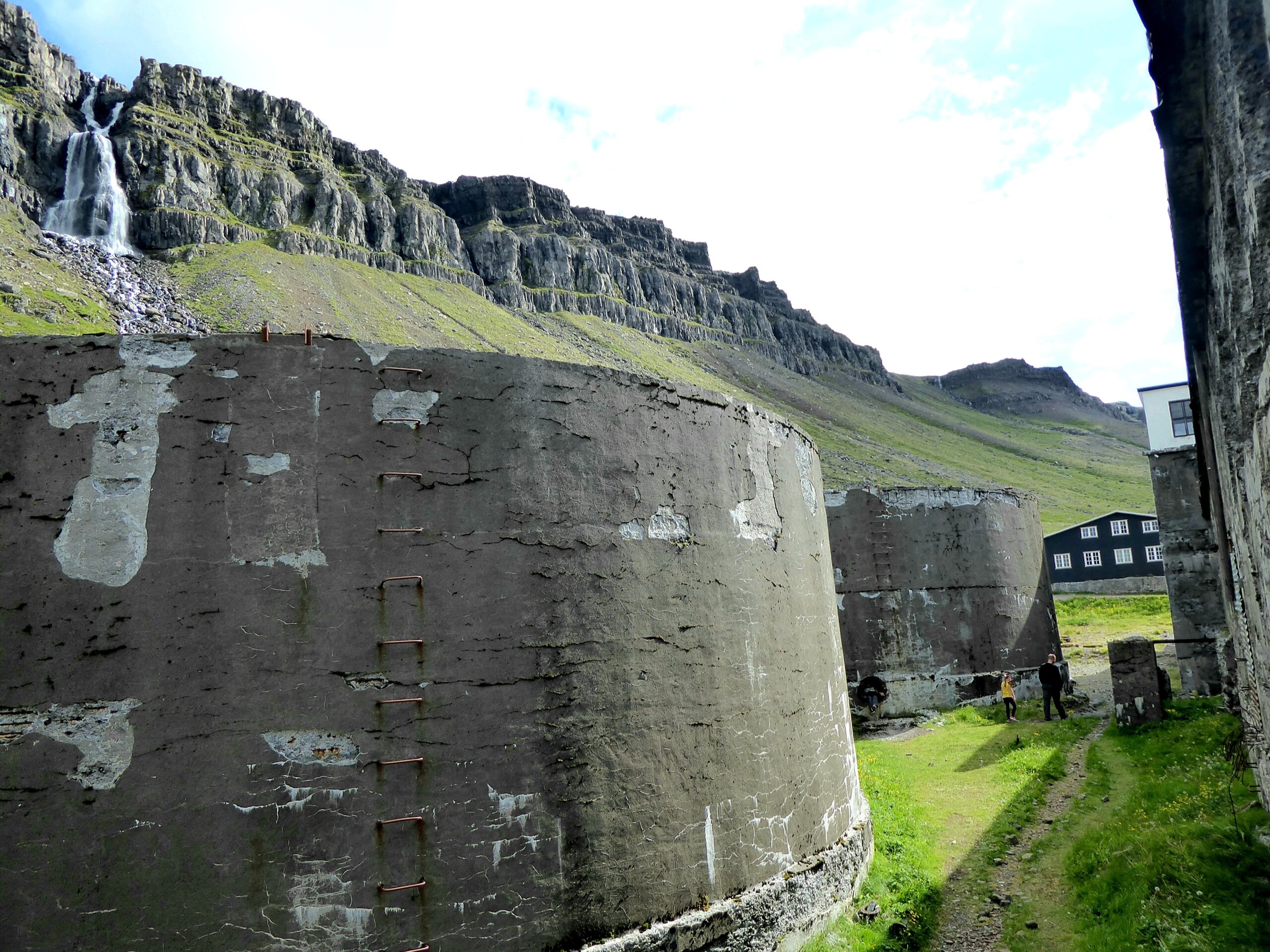
The story began when the last residents leaving Djupavik were featured on a television show piquing his father’s interest (his grandfather had some connection to the factory). After a visit his father was invited to buy it. In the end, his parents “a couple of hippies” were won over. The living quarters for the women workers, built in the 1930’s, was renovated and the hotel opened in 1985. The unique property is still their home and remains a work in progress. I imagined the fun he and his siblings would have had playing hide and seek there. He now had a family of his own to enjoy it.
Isafjordur is an old fishing town with an active harbor. Wooden buildings from the 18th and 19th century remain nestled on small streets not far from a modern mall, gas station, eateries, and shops.

I wanted to take a break from my wanderings and found a charming, cozy cottage, surrounded by hay fields, a stream, and a view of the hills. Silence was broken by the song of birds and the occasional car of a distant neighbor.
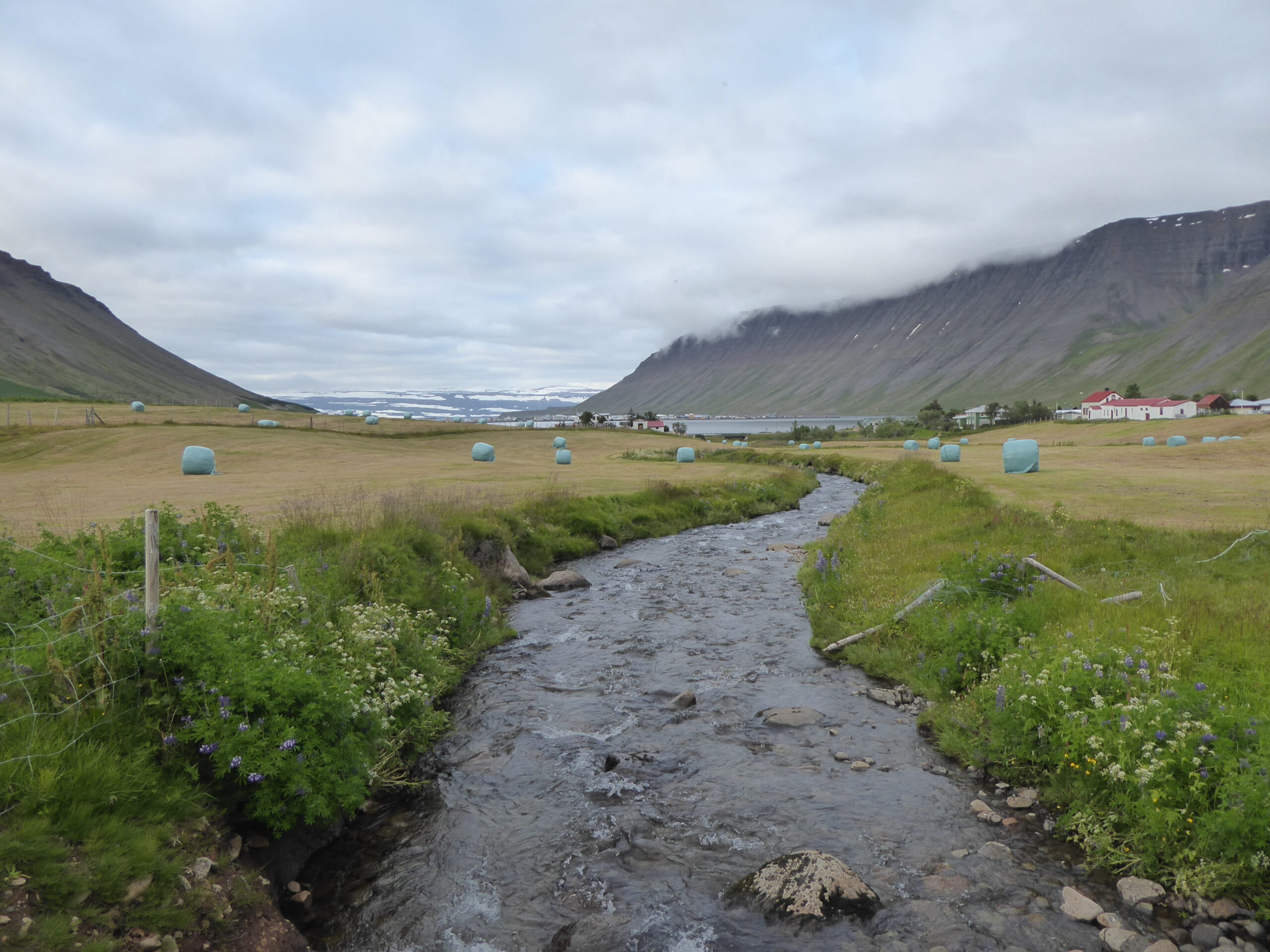
But the cottage shower, slightly sheltered, was outdoors. The first morning, with some trepidation, I walked outside donning the robe the owner had provided for this purpose. Attempting to be as deft as possible, I quickly got under a welcome gush of hot water. My body was instantly warmed while a chilly breeze blew around me. It was a splendid ritual I would perform for the next ten days.
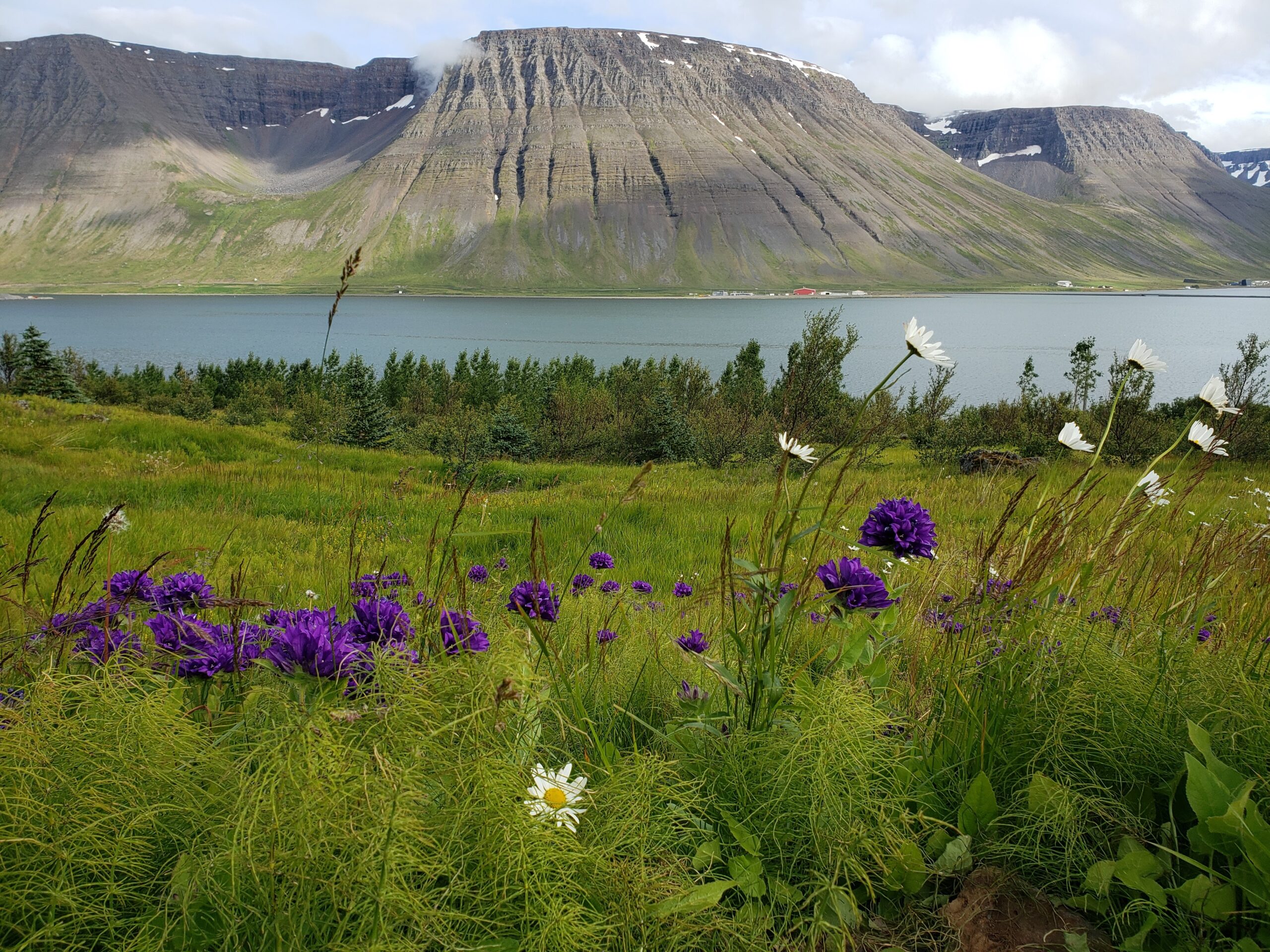
Town was about three miles away and there were several paths I could walk on to get there. Isafjordur had plenty to discover and enjoy.
The Westfjord History Museum showcased fishermen’s formidable relationship, in the past and today, with the sea. They also hosted a music series. I attended a memorable performance of a singer, who looked more lumberjack than troubadour, performing original tunes, Tom Waits covers, and Icelandic folk songs while accompanying himself on guitar–and joined by a string quartet.
The Nonsense Museum, just off the main street, displayed hundreds of bottle caps, Pez dispensers, match-boxes, and other curious collections.
And the Museum of Everyday Life had a wall of shoes with an audio narrative by the owner for each, a video of Icelanders who grew up thinking the Northern Lights were nothing special–until tourism showed them otherwise, and written stories by immigrants who now called Iceland home.
A place I kept returning to was the Eyrantuni Museum, originally a hospital opened in 1925. It housed a wonderful library with a selection of books in English, comfortable chairs, and a photography and art museum.
Out front was a large field where adults and children were often playing.
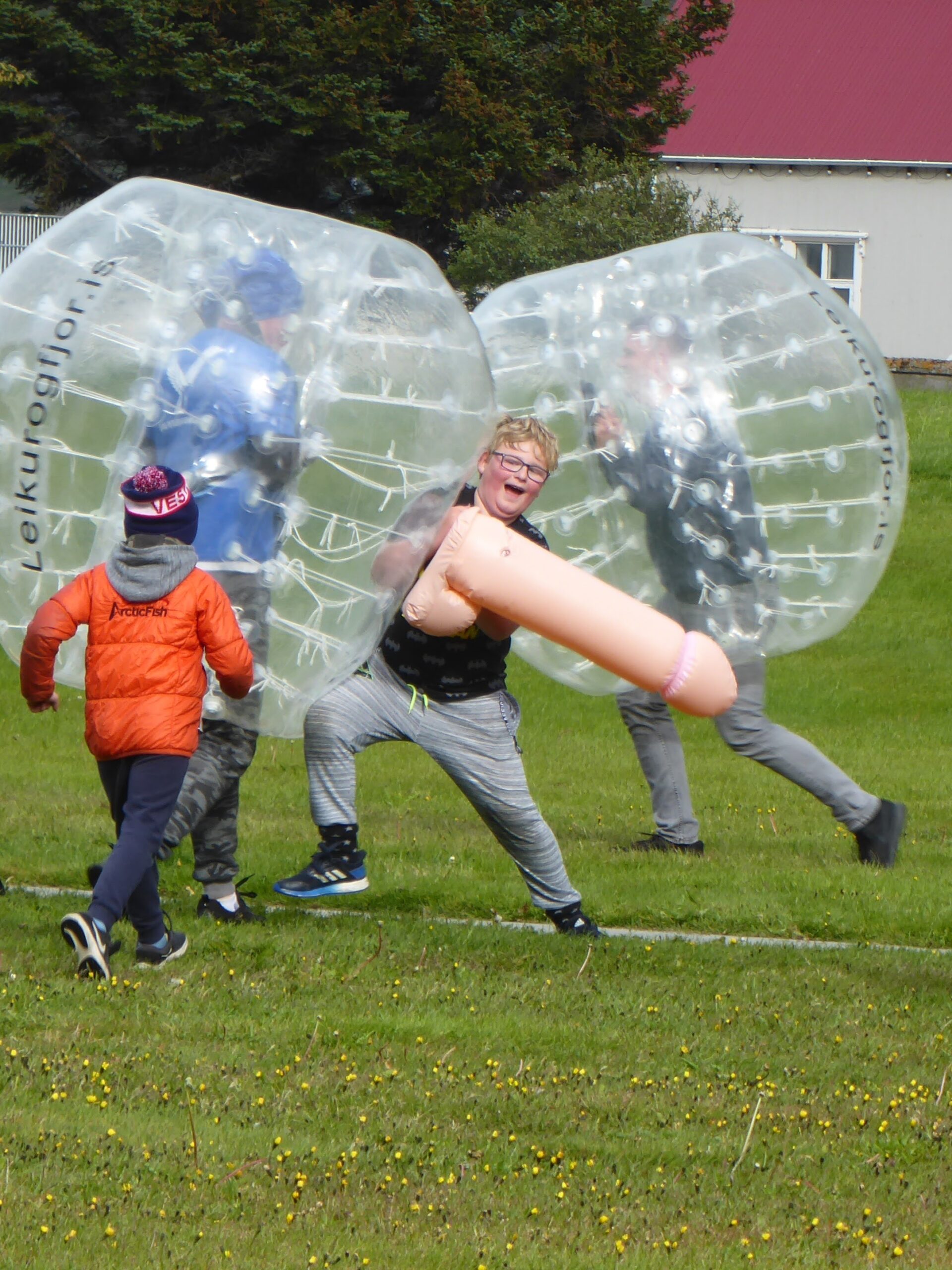
Normally that time of year massive ships would be unloading throngs of tourists to shop, eat, and fill the streets, but because of the pandemic the cruises stopped and the streets were largely empty. Although I was happy the town wasn’t inundated with day-trippers, I was sensitive to an economic hardship and asked a shop owner if this was a tough time. She surprised me by saying, “I’m enjoying the peace and quiet. It’s nice without the crowds.” Whether her sentiment represented others besides me, or if hers would last, I do not know.
But certain places were still thriving. The Tjoruhusid fish restaurant offered dinner service twice each evening, and getting a reservation for either was not easy. When I arrived the place was already packed. I was directed to one of several long wooden tables in the rustic wooden space, just a stone’s throw from the harbor, and was seated elbow to elbow and across from other diners. The buffet depended on the catch of the day and the owner/chef, who showed ample sign of enjoying his own cuisine, announced in a booming voice the menu for that evening first in Icelandic and then English. Fish chowder and brown bread were served, we then lined up to choose and be served from the-all-you-can-eat buffet of fish, vegetables, grains all prepared in a variety of ways.
Conversation flowed throughout the evening. Other travelers, from Germany, sat to my left. Across was an Icelandic couple who mentioned their concern that foreigners were bringing Covid into the country. Gently they were reminded that we had all been tested several times before we were allowed entry. The ambiance remained festive and after a superb meal, I walked back home around 10 p.m. The sunset was still an hour away.
The fourteen tunnels in Iceland were built to bypass hazardous mountain and coastal roads (not all were avoidable, as I learned) and the Vestfirdir Tunnel is the longest. It connects Isafjordur to the towns of Flateyri and Sudureyri and is nearly six miles (nine kms) long, mostly straight with only one lane. Oncoming cars can be seen from a distance and pull off areas—enough room for about three cars—permit the flow of traffic. Who has the right of way is determined by the direction you’re going in. But when to turn off requires decent depth perception in the dim tunnel –headlights are the guiding factor–and a healthy sense of self-preservation. Turn off too soon and you could be frustrating drivers behind you, turn off too late and it could require some awkward driving in reverse, or worse.
While visiting prosperous Reykjavik, arduous living conditions of the past (depicted beautifully and poignantly in Laxness’ Independent People) were hard to imagine, but I would happen upon remnants of those times.
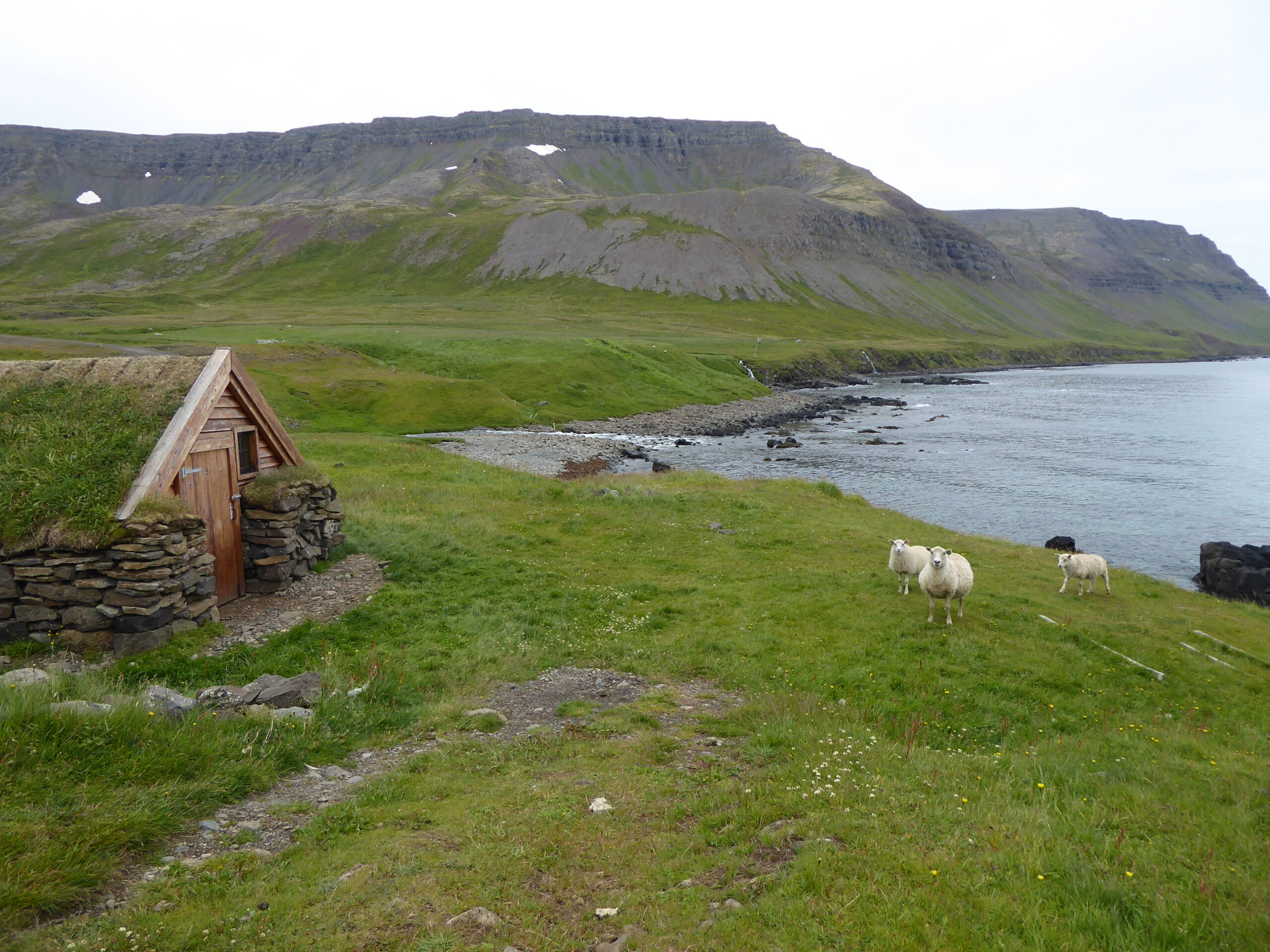
And even today, many Icelanders live a rugged existence. The other book I’d bought in Reykjavik, Heida: A Shepherd at the Edge of the World offers such an account. The future of sheep farming is threatened by rising costs and lower returns. As recent as the 1980’s sheep outnumbered people in Iceland by the hundreds of thousands, today their number is nearly equal. But for now, despite the hardships and difficulties, sheep farming prevails, and with it many traditions.
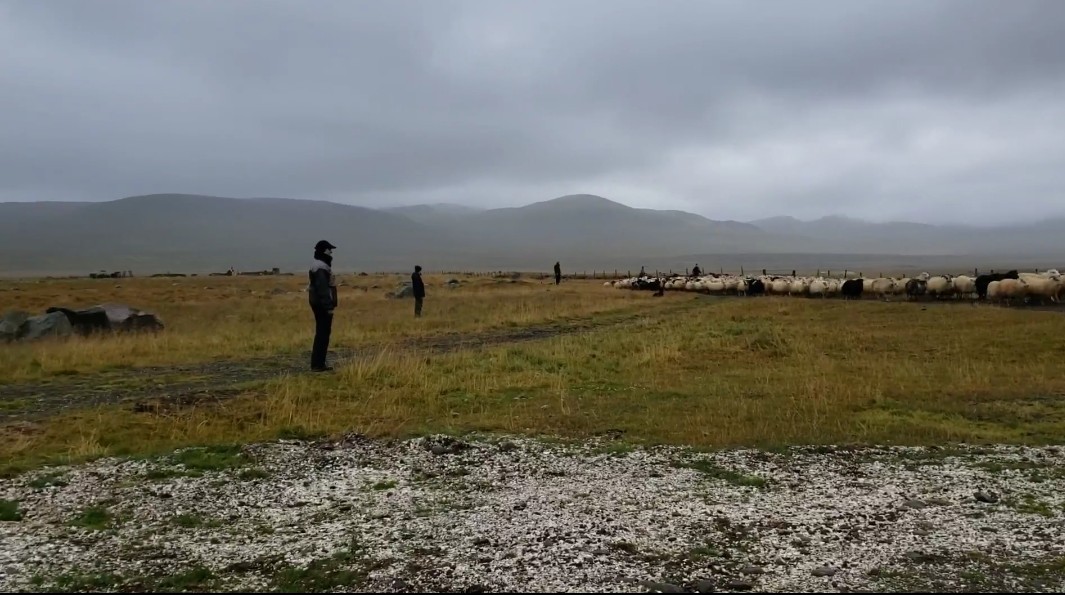
A few times I had to wait while sheep crossed the road in front of me. I’d give a wave to the shepherd and get a gesture of thanks in return.
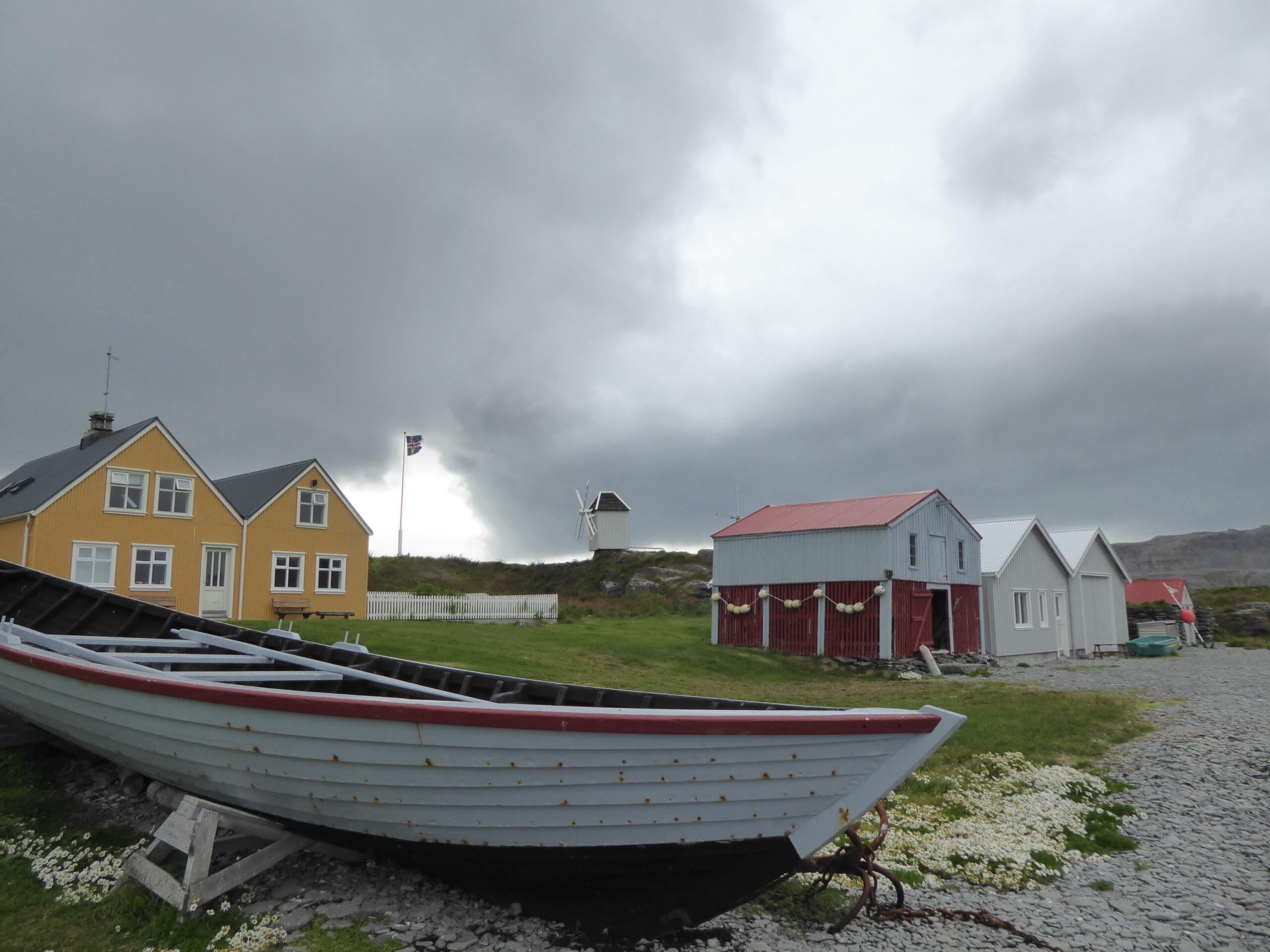
Vigur Island is a popular day trip from Isafjordur. The tiny island, about one mile long and a quarter of a mile wide, is a wildlife sanctuary where puffins, eider ducks, artic terns, black guillemots, and razorbills abound. Visitors generally come to see them on a three-hour tour, but I’d read the island was recently bought by a couple and accommodations were available for overnight stays. It was pricey, but I decided to splurge and booked a two night stay. Although the owners, Gisli and Felicity, were away, I made arrangements to be picked up by a relative from the nearby harbor of Sudavik.
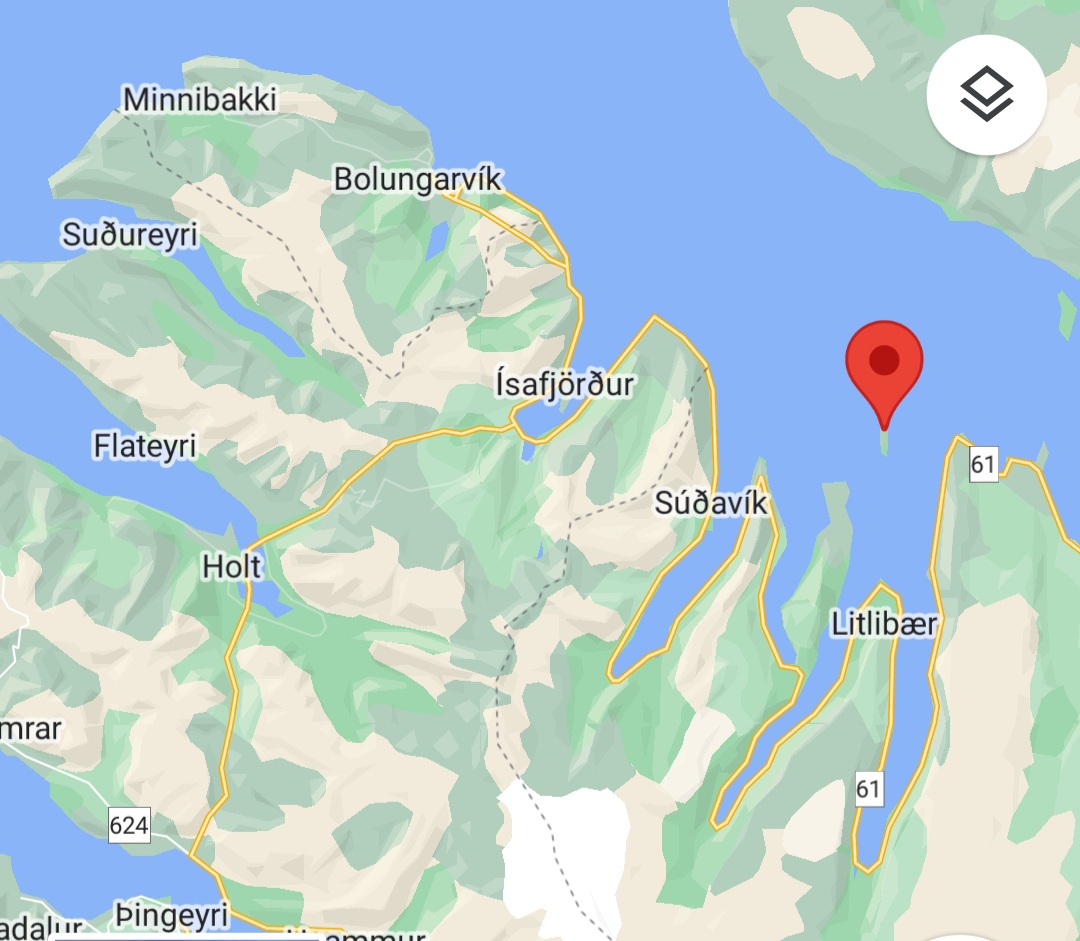
Arriving at the designated hour I was met by the owner’s nephew who looked quite young, and welcomed me aboard a small odd looking boat while dark clouds gathered overhead. The weather quickly took on a menacing air, the wind was picking up, and the sea was swelling with white caps. The boat bobbed with increasing frequency. Seeking some reassurance, I asked the young man if he’d crossed these waters many times. “No, just here for the holidays.” he said. I tried to return his response with a look of confidence. What should have been about a thirty-minute trip extended to over twice that: he was cautious and took it slow.
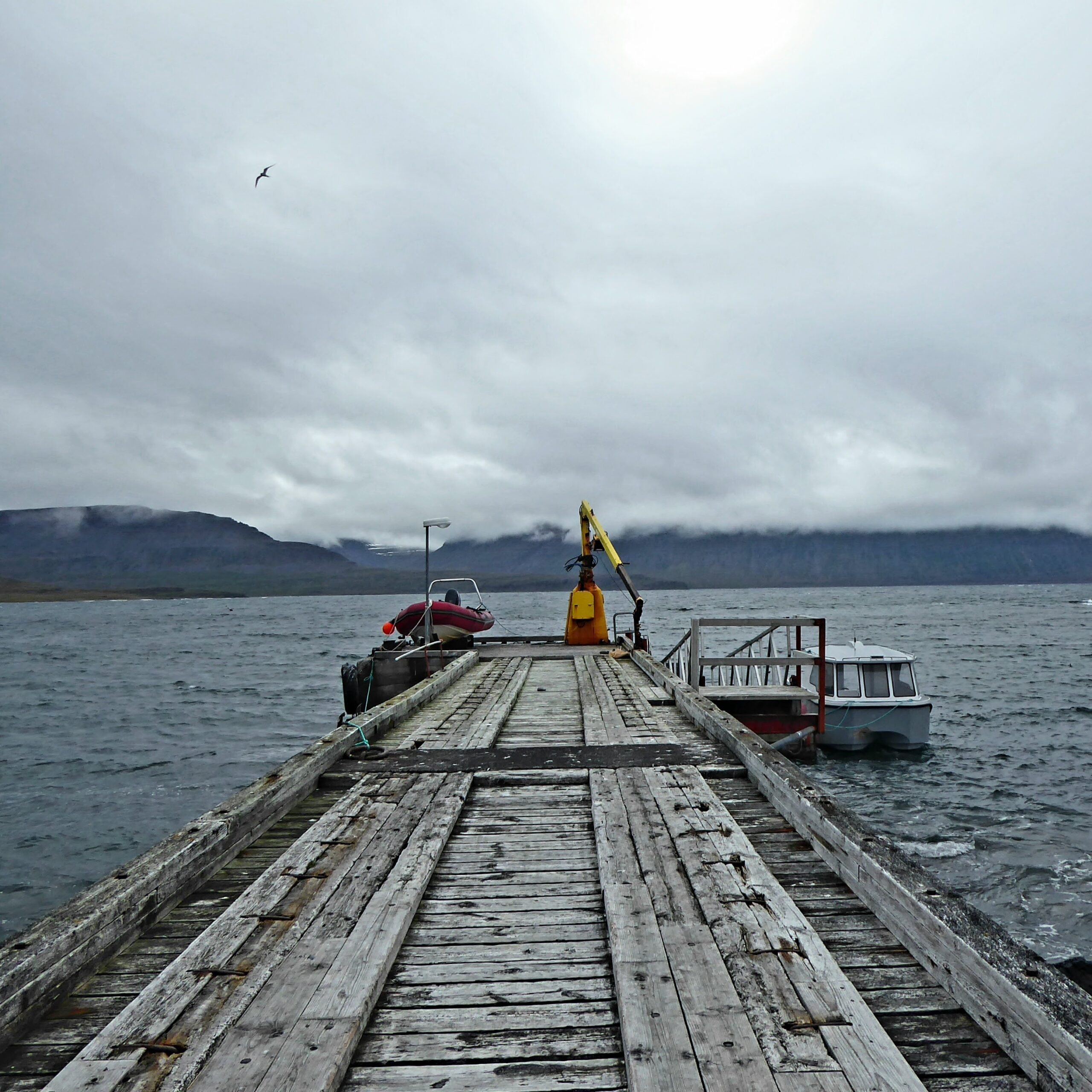
Pulling up to the pier, Gisli’s mom, sisters, and niece were there to welcome us. I was led past their dwelling and invited into an old wooden home with two bedrooms, sitting area, and full kitchen. I was the sole guest and they recommended I take the bedroom on the ground floor to avoid climbing the staircase/ladder. I did. The two homes were the only lodgings on the island–if one doesn’t include those of the countless birds.
The family invited me over after settling in. I unpacked the food I’d brought, meals were not included, and walked the few steps to my neighbors’ door. We sat around a large kitchen table, chatting, and enjoying homemade cakes, pancakes, and hot coffee.
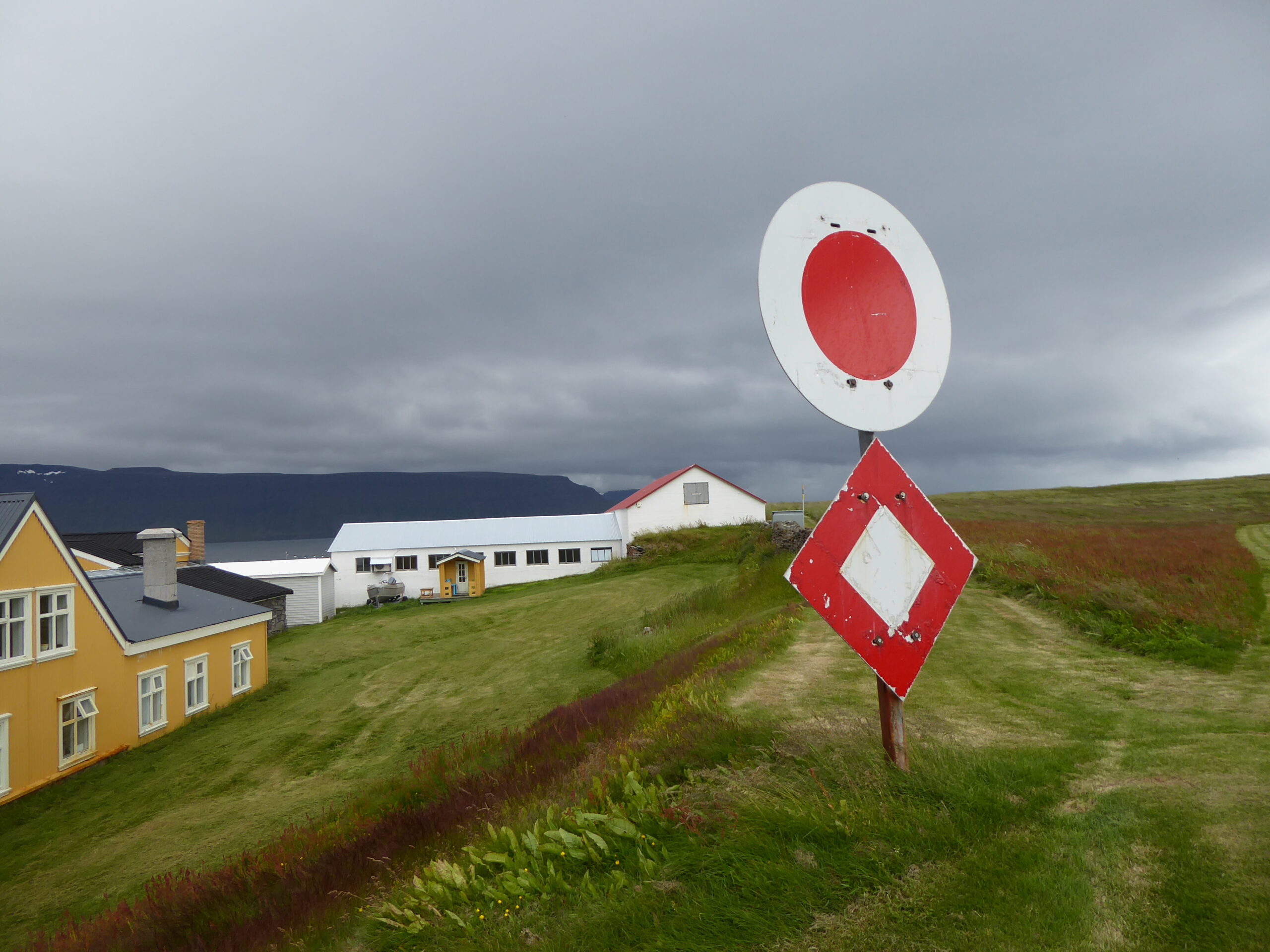
During the conversation Gisli’s mother mentioned that her son’s wife, Felicity Aston, had written some books and went on to describe them. Her English was hesitant and I wasn’t sure I’d understood all that she’d said. But I had. One was a first-person account of Ms. Aston skiing across the Antarctic land-mass alone—the first person to do so. And the other was Aston’s account of preparing for and leading a group of women from across the globe—including places where there was no snow—on a skiing expedition to the South Pole. The books were available for sale. I found room for both in my bag. (I encourage you to read more about this exceptional woman and her ongoing extraordinary expeditions.) http://www.felicityaston.co.uk/
Word arrived that tour boats scheduled to arrive that afternoon had been cancelled due to the rough sea. Our crossing had been the last of the day. Now free, the family offered to show me the island. We took sticks to keep the artic terns from dive bombing our heads and passed over fields once used for sustaining past inhabitants, before the eider down industry and tourism took over. The land rose toward the island’s center. Soil was soft underfoot where hundreds of puffins seasonally burrow their nests. Not falling into one took some effort.
When the family headed back I wandered toward the coast. Everywhere I looked was the marvel, grace, antics, and beauty of birds.
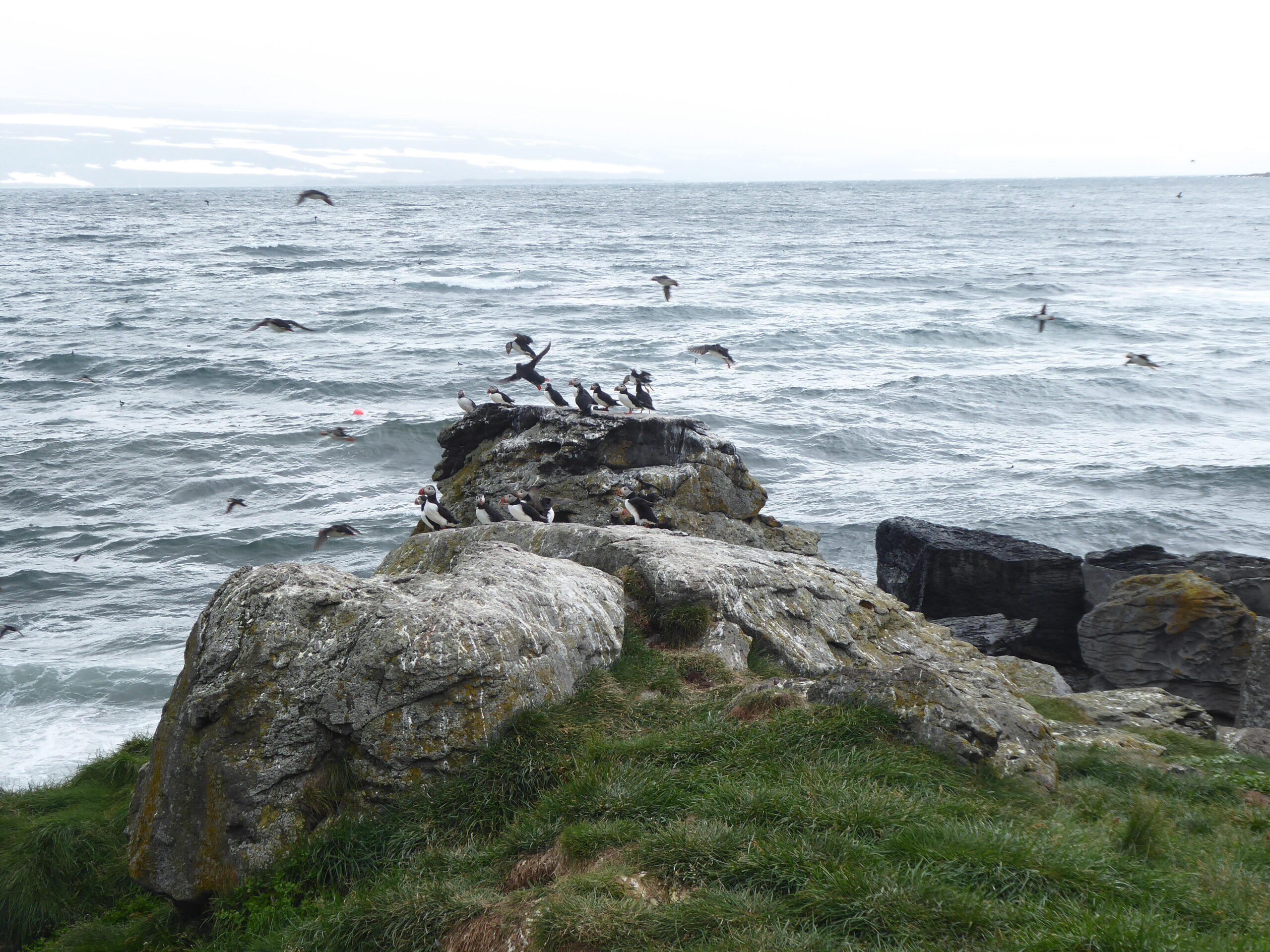
The following day the wind was strong and the sea was turbulent, but the weather did not impede my wanderings.
I didn’t see the family, who apparently preferred to stay indoors. It felt as if I had the entire island for myself—just me, and the thousands of birds.
I remained on the coast for hours, enthralled with the puffins as they flew overhead, convened on rocks, or emerged from their nests. They seemed quite content to gather in small groups and while away time before diving into the sea to fish and return again.
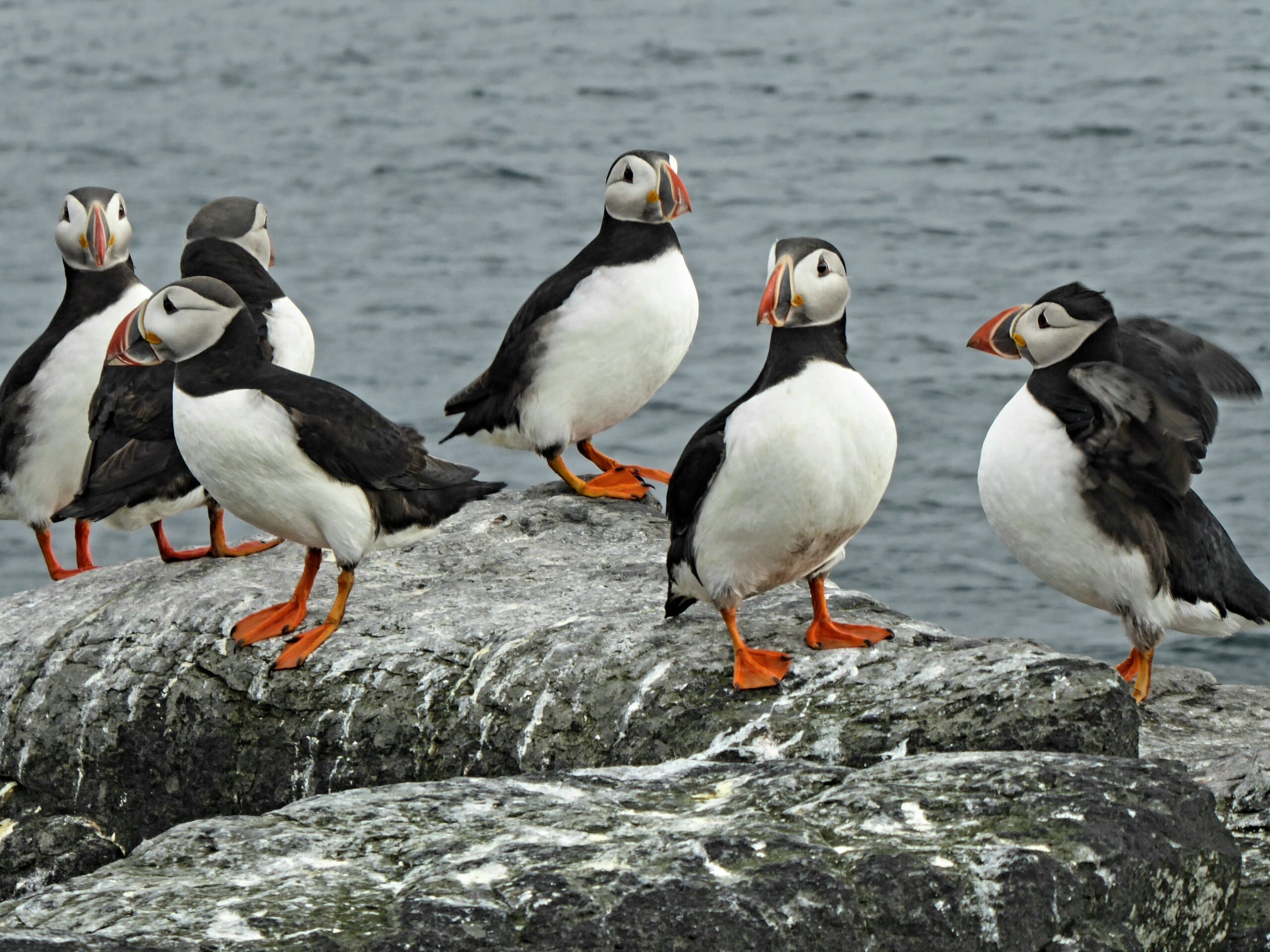
The morning I was scheduled to leave, the weather gods interceded. There would be no crossings again that day. The family invited me to stay the night as their guest and to drop by later for a meal.
I expressed my thanks and quickly headed toward the coast where I knew the puffins would be.
To be continued…
